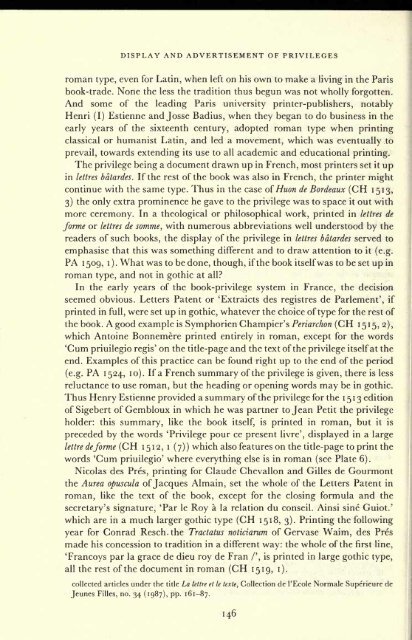Untitled - Monoskop
Untitled - Monoskop
Untitled - Monoskop
You also want an ePaper? Increase the reach of your titles
YUMPU automatically turns print PDFs into web optimized ePapers that Google loves.
DISPLAY AND ADVERTISEMENT OF PRIVILEGES<br />
roman type, even for Latin, when left on his own to make a living in the Paris<br />
book-trade. None the less the tradition thus begun was not wholly forgotten.<br />
And some of the leading Paris university printer-publishers, notably<br />
Henri (I) Estienne and Josse Badius, when they began to do business in the<br />
early years of the sixteenth century, adopted roman type when printing<br />
classical or humanist Latin, and led a movement, which was eventually to<br />
prevail, towards extending its use to all academic and educational printing.<br />
The privilege being a document drawn up in French, most printers set it up<br />
in lettres bdtardes. If the rest of the book was also in French, the printer might<br />
continue with the same type. Thus in the case of Huon de Bordeaux (CH 1513,<br />
3) the only extra prominence he gave to the privilege was to it space out with<br />
more ceremony. In a theological or philosophical work, printed in lettres de<br />
forme or lettres de somme, with numerous abbreviations well understood by the<br />
readers of such books, the display of the privilege in lettres bdtardes served to<br />
emphasise that this was something different and to draw attention to it (e.g.<br />
PA 1509, i ). What was to be done, though, if the book itself was to be set up in<br />
roman type, and not in gothic at all?<br />
In the early years of the book-privilege system in France, the decision<br />
seemed obvious. Letters Patent or 'Extraicts des registres de Parlement', if<br />
printed in full, were set up in gothic, whatever the choice of type for the rest of<br />
the book. A good example is Symphorien Champier's Periarchon (CH 1515, 2),<br />
which Antoine Bonnemere printed entirely in roman, except for the words<br />
'Cum priuilegio regis' on the title-page and the text of the privilege itself at the<br />
end. Examples of this practice can be found right up to the end of the period<br />
(e.g. PA 1524, 10). If a French summary of the privilege is given, there is less<br />
reluctance to use roman, but the heading or opening words may be in gothic.<br />
Thus Henry Estienne provided a summary of the privilege for the 1513 edition<br />
of Sigebert of Gembloux in which he was partner to Jean Petit the privilege<br />
holder: this summary, like the book itself, is printed in roman, but it is<br />
preceded by the words 'Privilege pour ce present livre', displayed in a large<br />
lettredeforme (CH 1512, i (7)) which also features on the title-page to print the<br />
words 'Cum priuilegio' where everything else is in roman (see Plate 6).<br />
Nicolas des Pres, printing for Claude Chevallon and Gilles de Gourmont<br />
the Aurea opuscula of Jacques Almain, set the whole of the Letters Patent in<br />
roman, like the text of the book, except for the closing formula and the<br />
secretary's signature, 'Par le Roy a la relation du conseil. Ainsi sine Guiot.'<br />
which are in a much larger gothic type (CH 1518, 3). Printing the following<br />
year for Conrad Resch.the Tractatus noticiarum of Gervase Waim, des Pres<br />
made his concession to tradition in a different way: the whole of the first line,<br />
'Francoys par la grace de dieu roy de Fran /', is printed in large gothic type,<br />
all the rest of the document in roman (CH 1519, i).<br />
collected articles under the title La lettre et le texte, Collection de 1'Ecole Normale Superieure de<br />
Jeunes Filles, no. 34 (1987), pp. 161-87.<br />
146

















